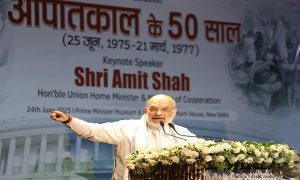Stories of Britishers looting Indian wealth during their 200-year rule are abound. The estimates made of the same are mind-boggling. Some say the British looted India of $3 trillion in today’s money. That may or may not be an accurate estimate, for it is indeed painstakingly tough to study the loot in detail, but one thing that can be said without any doubt is that the British debilitated India of its immense wealth and potential to leave it tottering as a third-world nation.
This article cites one such act of depriving India of what was its own. Of what took birth from its own soil but was taken away across seas to feed the extravagant desires of a Britisher. We talk of the Pitt Diamond or, how it is popularly known as today, the Regent Diamond.
The diamond in talk was found in the Kollur Mine in Andhra Pradesh in 1698 by a slave. It was a 400-carat uncut diamond. The diamond found its way to a merchant named Jamchand who then sold it to Thomas Pitt, the President of Madras. (Some accounts present a fascinating tale of how the diamond left the slave’s possession; they say he’d hid the diamond inside a self-inflicted wound in his thigh which was discovered by an English sea captain).
Pitt bought the diamond for £24,000 which was, back then, a sum 99 per cent of the British population couldn’t afford. It was sent back to Britain. Soon thereafter, Pitt gave up his governorship, went to Britain and bought a splendid mansion.
The cutting of the diamond began in 1704 and it took two years for it to be transformed into an uncut 141-carat gem. Many secondary stones were also produced from the cut and were sold to Russia’s Peter the Great.
In 1717, Thomas Pitt sold the diamond for a whopping £1,35,000 to Philippe II, the Duke of Orleans. The gem is now known as ‘Le Regent’ or the Regent diamond. It has adorned the crown of many a royal members of France. To name some – Louis XV, Louis XVI, and even Napoleon Bonaparte.
In about 15 years of space, without any work, Thomas Pitt got 5.6 times the money he’d put in. Money that originated, in a way, from Indian soil in the form of a priceless piece of beauty. Having come into such great fortune, Pitt enjoyed the lifestyle and subsequent respect of the elite of Britain. His family went on to produce two Prime Ministers – grandson William Pitt, 1st Earl of Chatham, and Chatham’s son, William Pitt ‘the Younger’.
One has to wonder whether without the diamond the Pitt dynasty would have risen to such political power? After all, it was the diamond that gave Thomas Pitt spectacular opulence and that opulence then gave him a place in high society, which, would’ve played no insignificant part in two of his future family members rising to the post of prime minister.
Today, the Regent Diamond is said to be the 7th largest D-colour diamond in the world. Its current worth is pegged at an incredible 48 million pounds!
To highlight the extraordinary riches that Indian princes had under British rule, I quote verbatim a portion of a paragraph from the book ‘Freedom At Midnight’: “…the future of India’s ruling princes, with their average of 11 titles, 5.8 wives, 12.6 children, 9.2 elephants, 2.8 private railway cars, 3.4 Rolls-Royces, and 22.9 tigers killed, posed a grave problem in the spring of 1947.” One can imagine the kind of wealth India still possessed despite ruthless British rule; it was just that the wealth had come to be accumulated at the wrong places. Either in the hands of vice-ridden, spineless princes or the elite in Britain. Absolutely nothing in the hands of the common Indian.
Sources: https://www.worthy.com/blog/knowledge-center/diamonds/famous-diamonds/the-regent-diamond/
‘An Era of Darkness’ by Shashi Tharoor




























 WhatsApp us
WhatsApp us